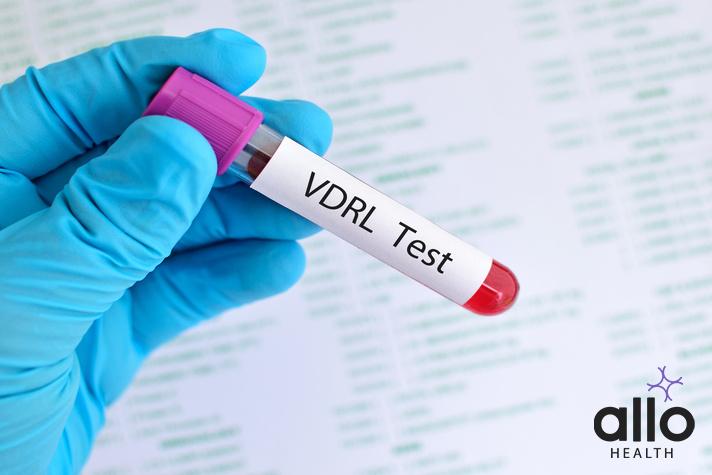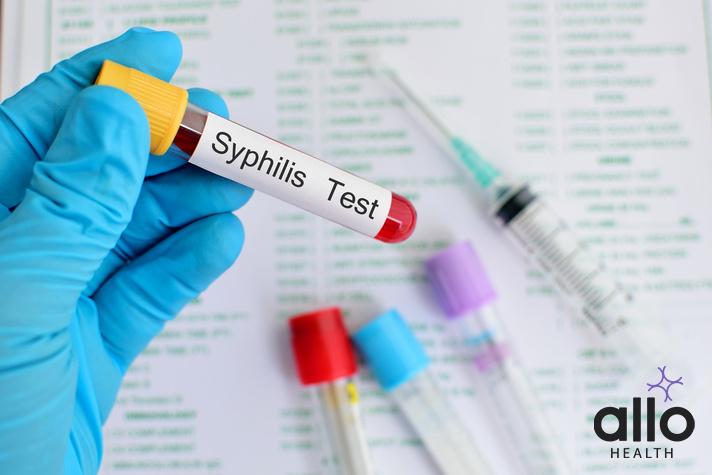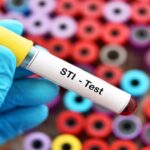TPHA Positive VDRL Negative for Syphilis: Diagnosis, Treatment, and Implications

Allo Health is dedicated to personalized well-being, offering support and trusted information tailored to individual health goals. The platform emphasizes human-generated content, led by a distinguished medical team of experts, including physicians and sexual health specialists. Their commitment to credibility involves rigorous fact-checking, authoritative research, and continuous updates to ensure accurate, up-to-date information. Allo Health's unique approach goes beyond conventional platforms, providing expert-led insights and a continuous commitment to excellence, with user feedback playing a crucial role in shaping the platform's authoritative voice.

Dr. Raj. R holds an undergraduate medical degree from the Philippines, and has a bachelors background in Psychology. His experience working in the field of urology further brought his interest forward in working towards his passion of understanding the science of attraction, intimacy, sex and relationships. A key motto he practices by remains unprejudiced and non-judgemental care.
Why This Was Upated?
Our experts continually monitor the health and wellness space, and we update our articles when new information became available.
Updated on 21 May, 2024
- Article was updated as part of our commitment to diversity, equity, and inclusion.

"The following blog article provides general information and insights on various topics. However, it is important to note that the information presented is not intended as professional advice in any specific field or area. The content of this blog is for general educational and informational purposes only.
Book consultation
The content should not be interpreted as endorsement, recommendation, or guarantee of any product, service, or information mentioned. Readers are solely responsible for the decisions and actions they take based on the information provided in this blog. It is essential to exercise individual judgment, critical thinking, and personal responsibility when applying or implementing any information or suggestions discussed in the blog."
Syphilis infection remains a significant public health concern globally, necessitating accurate diagnosis and prompt treatment to prevent severe complications. Among the complexities of syphilis diagnosis is the scenario of being TPHA positive and VDRL negative. This article aims to elucidate this particular diagnostic outcome, exploring its implications, stages of syphilis, testing methods, treatment options, and the importance of healthcare provider involvement.
What is Syphilis?
- Syphilis is a bacterial infection caused by Treponema pallidum, typically transmitted through sexual contact or exposure to syphilis sores. The infection progresses through primary, secondary, latent, and tertiary stages, each with varying symptoms and complications.
- Symptoms can range from painless sores or chancres in the primary stage to rash, fever, and swollen lymph nodes in the secondary stage. Latent syphilis may remain asymptomatic for years, posing risks of transmission and complications, including congenital syphilis in pregnant individuals.
- Diagnosis involves blood tests such as VDRL and TPHA, with interpretation by healthcare providers based on clinical history and risk factors.
- Prompt treatment with antibiotics like penicillin is crucial to prevent severe complications like cardiovascular disease or neurosyphilis. Regular testing and access to healthcare services are vital for early detection and successful management of syphilis infections.
What are TPHA and VRDL Tests?
TPHA (treponema pallidum hemagglutination assay) and VDRL (venereal disease research laboratory) tests for syphilis as diagnostic tools:
TPHA Test:
- TPHA is a treponemal antibody test that detects antibodies specifically targeting the bacterium causing syphilis, Treponema pallidum from blood samples.
- It is considered highly sensitive and specific for syphilis diagnosis, providing confirmation of exposure to the syphilis bacterium.
- TPHA is often used as a confirmatory test following initial screening with non-treponemal tests like VDRL or RPR.
- Positive TPHA results indicate past or current infection with syphilis, as the body produces antibodies in response to the bacterium.
VDRL Test:
- VDRL is a nontreponemal test that detects antibodies produced by the body in response to syphilis infection.
- It measures the reactivity of antibodies present in the blood serum to lipids released from damaged host cells and the syphilis bacterium.
- VDRL is commonly used as an initial screening test for syphilis due to its ease of use and relatively low cost.
- A negative VDRL result indicates the absence of detectable antibodies associated with active syphilis infection, though false negatives can occur, especially in early stages of infection or in individuals with autoimmune diseases.
However, being TPHA positive and VDRL negative for syphilis may indicate various stages of syphilis infection, false-negative VDRL results, or previous treatment.
What Does Positive TPHA Result Means?
A positive TPHA (Treponema Pallidum Hemagglutination Assay) result indicates the presence of antibodies against the bacterium responsible for syphilis infection. This suggests exposure to syphilis at some point, triggering the body’s immune response to produce antibodies. However, it doesn’t necessarily confirm an active infection, as antibodies may persist even after successful treatment or during latent stages of the disease.
Positive TPHA results warrant further assessment, including clinical evaluation, additional testing such as VDRL (Venereal Disease Research Laboratory) or RPR (Rapid Plasma Reagin) tests, and consideration of individual risk factors and medical history. Interpretation of TPHA results in conjunction with other diagnostic tests and clinical findings is crucial for accurate diagnosis and appropriate management by healthcare providers.
What Does Negative VDRL Result Means?

A negative VDRL (Venereal Disease Research Laboratory) result indicates the absence of detectable nontreponemal antibodies associated with syphilis infection. This outcome suggests several possibilities:
- Early Infection: The absence of antibodies may occur during the initial stages of syphilis infection, before the body mounts a detectable immune response.
- Previous Treatment: Individuals who have received adequate antibiotic therapy for syphilis may show negative VDRL results due to the elimination of the bacterium and associated antibodies from their system.
- False-Negative: In some cases, false-negative results can occur due to laboratory error, inadequate sample collection, or other factors affecting test accuracy.
- Low Risk: A negative VDRL result may indicate a low risk of active syphilis infection, especially when interpreted in conjunction with clinical history and additional testing, such as treponemal antibody tests like TPHA confirmation.
Understanding the implications of a negative VDRL result requires careful consideration of clinical context and further evaluation when necessary.
What Does TPHA Positive and VDRL Negative for Syphilis Means?

When a person’s TPHA (Treponema Pallidum Hemagglutination Assay) test is positive for syphilis antibodies but their VDRL (Venereal Disease Research Laboratory) test is negative, it can indicate several scenarios:
- Early Infection: TPHA positivity suggests exposure to syphilis, but VDRL negativity may occur during the early stages of infection before detectable antibodies develop.
- Previous Treatment: A TPHA positive, VDRL negative result could indicate past syphilis infection that has been successfully treated, resulting in the absence of active infection and non-reactivity in the VDRL test.
- False-Negative VDRL: In some cases, the VDRL test may yield false-negative results, leading to VDRL negativity despite the presence of syphilis infection. This underscores the importance of additional confirmation testing and clinical assessment by a healthcare provider.
- Interpretation Challenges: Healthcare providers must carefully assess the individual’s clinical history, symptoms, and risk factors to determine the significance of the test results and guide appropriate management, which may include further testing and monitoring for disease progression or reinfection.
TPHA positive and VDRL negative for syphilis indicate potential exposure or past infection, but accurate interpretation requires consideration of various factors and may necessitate additional testing and clinical evaluation.
Why do TPHA and VDRL Test Results Sometime Differ?
Specificity and Sensitivity:
- TPHA detects treponemal antibodies, offering high specificity for syphilis but may remain positive even after successful treatment.
- VDRL, a nontreponemal test, is sensitive to changes in antibody levels but may yield false-negative results, especially in early or late stages of infection.
Stage of Infection:
- Early in infection, TPHA may be positive while VDRL remains negative due to insufficient antibody levels.
- Conversely, during late latent or tertiary stages, VDRL may become non-reactive despite persistent TPHA positivity, reflecting waning antibody levels.
Treatment Status:
- Following successful treatment, VDRL titers typically decline, while TPHA may remain positive, indicating past exposure.
Cross-Reactivity and False Positives:
- VDRL can yield false-positive results due to various factors, including autoimmune diseases, while TPHA is less prone to cross-reactivity.
Clinical Interpretation:
- Healthcare providers must consider the clinical context, including symptoms, risk factors, and additional testing, to accurately interpret TPHA and VDRL results and guide appropriate management.
How to Confirm Syphilis?
- Treponemal Antibody Testing: Perform additional treponemal antibody tests, such as FTA-ABS (Fluorescent Treponemal Antibody Absorption) or TP-PA (Treponema Pallidum Particle Agglutination), to confirm the presence of specific antibodies against syphilis. These tests can help corroborate the TPHA positive result and provide further evidence of syphilis infection.
- Clinical Assessment: Conduct a comprehensive clinical evaluation, considering the patient’s medical history, symptoms, and potential risk factors for syphilis acquisition. Clinical manifestations, such as the presence of painless sores, rash, or other indicative symptoms, can support the diagnosis.
- Additional Laboratory Testing: Utilize other laboratory tests, such as PCR (Polymerase Chain Reaction) testing or dark-field microscopy, to detect the presence of Treponema pallidum bacteria directly. These tests can aid in confirming active syphilis infection, particularly in cases where serological results are inconclusive.
- Follow-Up Testing: Repeat serological testing at a later time to monitor changes in antibody levels over time. A rising titer of syphilis antibodies may indicate active infection or treatment failure, prompting further investigation and management.
- Consultation with Healthcare Provider: Seek guidance from a qualified healthcare professional or specialist in infectious diseases for interpretation of test results and formulation of an appropriate management plan. Collaboration with healthcare providers ensures thorough assessment and timely intervention for individuals with suspected syphilis infection.
Importance of Timely Testing and Treatments for Syphilis
Timely testing and treatment for syphilis are paramount to prevent disease progression and complications:
- Early Detection: Prompt testing allows for early diagnosis of syphilis, enabling timely intervention and reducing the risk of transmission to sexual partners or unborn children during pregnancy.
- Prevention of Complications: Timely treatment helps prevent the development of severe complications associated with syphilis, such as cardiovascular disease or neurological disorders.
- Public Health Impact: Rapid identification and treatment of syphilis cases contribute to the control of disease spread within communities, lowering overall rates of syphilis infection.
- Healthcare Utilization: Access to regular testing facilitates early detection of syphilis among at-risk populations, ensuring appropriate medical care and management by qualified healthcare providers.
- Effective Antibiotic Therapy: Initiating antibiotic therapy promptly can effectively eradicate the syphilis bacterium, reducing the risk of long-term health consequences and promoting successful treatment outcomes.
Timely testing and treatment for syphilis are essential components of comprehensive healthcare strategies aimed at curbing disease transmission and improving individual health outcomes.
Conclusion
Understanding the significance of being TPHA positive and VDRL negative for syphilis involves recognizing the complexities of syphilis infection, diagnostic testing, and treatment strategies. Healthcare providers play a crucial role in assessing and managing individuals with this test outcome, ensuring timely intervention and successful treatment outcomes. Continued efforts in syphilis prevention, diagnosis, and treatment are essential to mitigate the burden of this infectious disease and its associated complications.
Most Asked Questions
-
What does it mean to be TPHA positive and VDRL negative for syphilis?
When you’re TPHA positive and VDRL negative, it suggests you’ve been exposed to syphilis, but your body hasn’t produced enough antibodies for the VDRL test to detect yet. This could be because you’re in the early stages of infection or have had previous treatment.
-
How is syphilis diagnosed?
Syphilis is diagnosed through a combination of clinical evaluation and blood tests. Common tests include the VDRL and RPR tests to detect antibodies, along with the TPHA test specifically for syphilis antibodies.
-
What are the treatment options for syphilis?
The main treatment for syphilis is antibiotics, usually penicillin. However, alternatives are available for those allergic to penicillin. Treatment depends on the stage of infection and may require multiple doses or courses of antibiotics.
-
Why is it important to seek healthcare provider guidance for syphilis testing and treatment?
Healthcare providers play a crucial role in interpreting test results, determining the appropriate treatment, and monitoring your progress. They can also provide guidance on preventive measures, such as safe sexual practices, and help prevent the spread of syphilis to sexual partners or unborn children.






































